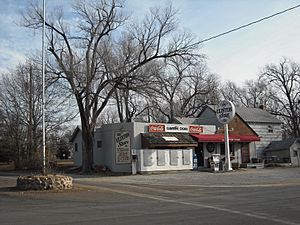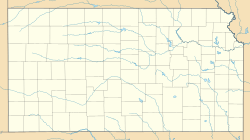Clinton, Kansas facts for kids
Quick facts for kids
Clinton, Kansas
|
|
|---|---|

"the Clinton Store" in Clinton (2008)
|
|

|
|
| Country | United States |
| State | Kansas |
| County | Douglas |
| Elevation | 935 ft (285 m) |
| Time zone | UTC-6 (CST) |
| • Summer (DST) | UTC-5 (CDT) |
| Area code | 785 |
| FIPS code | 20-14300 |
| GNIS ID | 479107 |
Clinton is an unincorporated community in Douglas County, Kansas, United States. It sits on a piece of land next to Clinton Lake. An "unincorporated community" means it's a group of homes and businesses that doesn't have its own official city government.
Contents
History
The Early Days: Bloomington
The area was first settled in June 1854. It was called Bloomington starting in April 1855. That's when Harrison Burson asked the U.S. Government for a post office there. Within eight months, about 530 people had moved to the Bloomington-Clinton area.
The people of Bloomington were strongly against slavery. They even helped enslaved people escape to freedom using the Underground Railroad. In early 1857, the northern part of Bloomington moved to a new spot. The southern part of the community was then renamed Winchester.
Winchester Becomes Clinton
Winchester was named after a city in Illinois, just like Bloomington was. Later that year, Bloomington decided to become an official, "incorporated" city. This means it would have its own local government. Winchester followed suit just four days later. On February 20, 1857, Winchester officially became an incorporated city. It was given the name Clinton, after Clinton, Illinois.
Clinton Grows and Changes
Clinton and Bloomington were only about three miles apart, so they quickly became rivals. Bloomington started to lose out in 1858. On August 30, the post office was moved from Bloomington to Clinton.
Within its first five years, Clinton built two schoolhouses, two churches, and a town hall. In 1869, the Clinton Cemetery was officially started. It was on land already used for burials. It is thought to be one of the oldest burial grounds in Douglas County.
A railroad called the Lawrence & Emporia Railroad was built through Bloomington and Clinton in 1873. But other, bigger railroads soon made its route less important. So, it was closed down by 1894. By 1876, most of Bloomington had turned back into farmland. It was considered an empty area. The post office in Clinton closed in 1927.
In the mid-1960s, land was bought to build Clinton Lake. The entire town of Bloomington was bulldozed. Only the J.C. Steele house and a milk shed were left standing. The house was added to the National Register of Historic Places in 1979. However, it was later torn down, leaving only its foundations and stairs. The old milk shed is still there. It is now the Clinton Lake Museum, located near Bloomington Beach in the Bloomington Recreation Area.
A Time of Conflict: Bleeding Kansas
In August 1856, the main supply route to Lawrence was blocked. People had to travel to Lecompton, which was a strong supporter of slavery. During this time, Henry Hiatt and others were taken prisoner. About fifty pro-slavery men then started marching towards Bloomington.
A group of 400 to 800 men marched towards Lecompton. They avoided a direct fight. However, this led to the looting and burning of Colonel Henry T. Titus's home. This event is known as the Battle of Fort Titus.
Later, in 1863, a small group from William Quantrill's raid on Lawrence rode through Bloomington. They caused more damage when they passed through Lone Star. Lone Star is about five miles south of Clinton.
Education
The public schools in Clinton are part of the Lawrence USD 497 school district.




